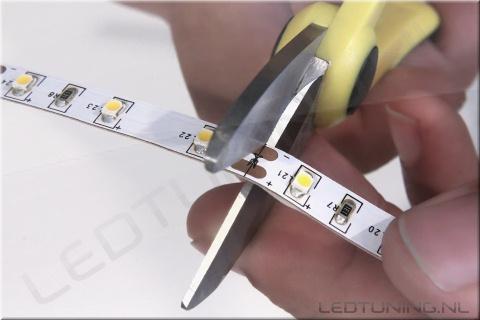LED-strips shorten/ lengthen
A LED strip of 5 meters cannot simply be extended. The following must be taken into account, namely with the maximum power of the entire LED strip. It can happen that an LED strip shows brightness or color difference at the end of the LED strip. This is because the voltage in the strip decreases the further away from the power source. The thin copper traces in the LED strip cannot handle large currents and therefore voltage drop may occur.
For this reason, long lengths of LED strips must be fed in several places. Another solution is to wire the LED strip in the middle, which has a much lower voltage drop than the LED strip itself. If the length of the strip becomes so long that the current becomes too great for the output of the dimmer or controller, then signal / current amplifiers (data repeaters) must be used. If the total power is greater than the power supply can handle in terms of wattage, a distribution must be made over several power supplies.
LED strips are easy to shorten or extend in any desired size. If the LED strip is too long, it can be shortened by cutting one of the copper cutting marks. The strip can be cut with ordinary scissors. Depending on the type of LED strip, the cutting lines are usually placed every 5 or 10cm. In addition to the cut marks, there is usually a soldering tip every 50 cm. This can also be cut with scissors. Soldering tips are also used to solder two LED strips together
We call the piece of LED strip between the cut lines a segment. The strip can only be shortened per segment. Sometimes a cutting line coincides with a solder. In that case, cut the 3M protective layer on the back of the strip and solder the solder points on top of the strip.
Soldering is the most solid way to extend LED strips. It is strong and very solid. An alternative to soldering is the extension of strips by means of click connectors. However, these click connectors are less stable than when you solder.
Shortening a water-resistant strip is possible. However, the function of the waterproof protective layer is lost when you cut it. If the strip does not come into contact with water, this is not a problem. If you want to use the strip outside or in a damp room, it is important that the strip remains waterproof. You can cut the LED strip yourself. After cutting, place a silicone end cap.
[video:https://www.youtube.com/watch?v=KtI58qPvgPU]



